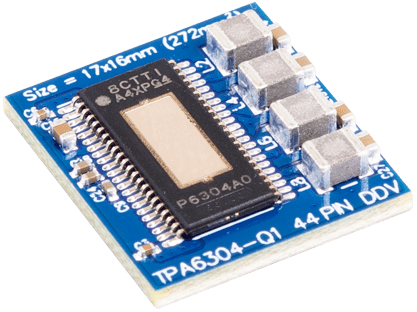SLASEP6B September 2019 – December 2020 TPA6304-Q1
PRODUCTION DATA
- 1 Features
- 2 Applications
- 3 Description
- 4 Revision History
- 5 Pin Configuration and Functions
- 6 Specifications
- 7 Parameter measurement information
-
7 Detailed Description
- 7.1 Overview
- 7.2 Functional Block Diagram
- 7.3
Feature Description
- 7.3.1 Single-Ended Analog Inputs
- 7.3.2 Gain Control
- 7.3.3 Class-D Operation and Spread Spectrum Control
- 7.3.4 Gate Drive
- 7.3.5 Power FETs
- 7.3.6
Load Diagnostics
- 7.3.6.1
DC Load Diagnostics
- 7.3.6.1.1 Automatic DC Load Diagnostics at Device Initialization
- 7.3.6.1.2 Automatic DC Load Diagnostics During Hi-Z to MUTE or PLAY Transition
- 7.3.6.1.3 Manual Start of DC Load Diagnostics
- 7.3.6.1.4 Short-to-Ground
- 7.3.6.1.5 Short-to-Power
- 7.3.6.1.6 Shorted Load and Open Load
- 7.3.6.1.7 Line Output Diagnostics
- 7.3.6.2 AC Load Diagnostics
- 7.3.6.1
DC Load Diagnostics
- 7.3.7 Power Supply
- 7.3.8 Device Initialization and Power-On-Reset (POR)
- 7.3.9 Protection and Monitoring
- 7.3.10 Hardware Control Pins
- 7.4
Device Functional Modes
- 7.4.1 Internal Reporting Signals
- 7.4.2 Device States and Flags
- 7.4.3 Fault Events
- 7.4.4 Warning Events
- 7.5 Programming
- 7.6 Register Maps
- 8 Application Information Disclaimer
- 9 Power Supply Recommendations
- 10Layout
- 11Device and Documentation Support
Package Options
Mechanical Data (Package|Pins)
- DDV|44
Thermal pad, mechanical data (Package|Pins)
- DDV|44
Orderable Information
3 Description
The TPA6304-Q1 device is a four-channel analog-input Class-D Burr-Brown™ audio amplifier that implements a 2.1 MHz PWM switching frequency that enables a cost optimized solution in a very small 2.7 cm2 PCB size, high impedance single ended inputs and full operation down to 4.5 V for start/stop events.
The TPA6304-Q1 Class-D audio amplifier has an optimal design for use in entry level automotive head units that provide analog audio input signals as part of their system design. The Class-D topology dramatically improves efficiency over traditional linear amplifier solutions.
The output switching frequency can be set either above the AM band, which eliminates the AM band interference and reduces output filter size and cost, or below AM band to further optimize efficiency.
The device is offered in a 44 pin HTSSOP package with the exposed thermal pad up.
| PART NUMBER | PACKAGE(1) | BODY SIZE (NOM) |
|---|---|---|
| TPA6304-Q1 | HTSSOP (44) | 14.00 mm × 6.10 mm |
 Reference Board
Reference Board